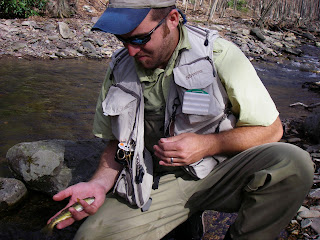Took the opportunity to tye with fellow fly fisherman and friend Matt Grobert today at Shannon's fly shop in Califon NJ. He came armed with a great line up of flys that not only fish well but are easy to tye..
First up to bat was a great little larva pattern the Chimarra Caddis Larva. It uses three tying materials well four once you count head cement or hard as hull to finish the fly.Tying the fly is rather simple and is done with the following materials; hook size 18 , thread yellow or bright orange for the under body, uni-flex in a red orange and brown or black thread to finish the head.When you are finished tying the fly coat the entire body and head with hard as hull to give it that great translucent look .
Next was one of Matts favorite flys to fish the Sparkle Caddis pupa. This was good as I have never tied this fly, I have a few in stock given to me by Matt and Jessy whom tye these beautifully.
I can vouch for the effectiveness of this fly it just down right produces. I have taken many fish with this fly on top as well as pulling it under and letting it pop back to the surface.These are typically tied on a size 14-18 dry fly hook.
And last but not least the Snow Shoe Hendrickson emerger . Which is a great early season pattern here in the Northeast as it is one of the first and best mayfly hatches of the year. These can be tied on a curved or straight shank hook in sizes 12-14.
All I can say is we had great time tying with Matt and learning a few of his tying tricks along the way . He also shared a few fish tales with some funny jokes peppered in that got everyone going.It was definitely worth getting up early Sunday morning and driving down to Shannon's Fly Shop in Califon NJ for their free fly tying class. I know I walked away with some newly gained knowledge and had fun to boot!
If you would like the recipes for the patterns above they can be found in Matts book Fly Fishing New Jersey Trout Streams. It can be purchased online at Shannon's Fly Shop.
I can vouch for the effectiveness of this fly it just down right produces. I have taken many fish with this fly on top as well as pulling it under and letting it pop back to the surface.These are typically tied on a size 14-18 dry fly hook.
And last but not least the Snow Shoe Hendrickson emerger . Which is a great early season pattern here in the Northeast as it is one of the first and best mayfly hatches of the year. These can be tied on a curved or straight shank hook in sizes 12-14.
All I can say is we had great time tying with Matt and learning a few of his tying tricks along the way . He also shared a few fish tales with some funny jokes peppered in that got everyone going.It was definitely worth getting up early Sunday morning and driving down to Shannon's Fly Shop in Califon NJ for their free fly tying class. I know I walked away with some newly gained knowledge and had fun to boot!
If you would like the recipes for the patterns above they can be found in Matts book Fly Fishing New Jersey Trout Streams. It can be purchased online at Shannon's Fly Shop.
































